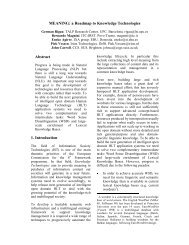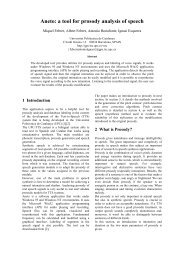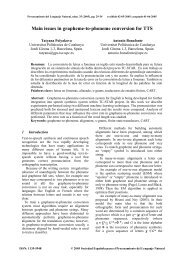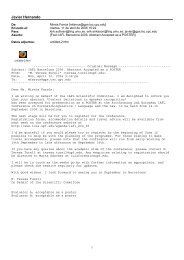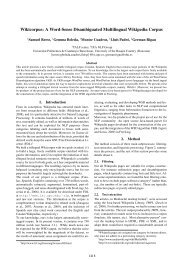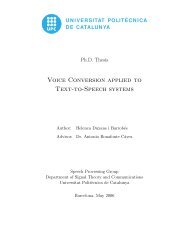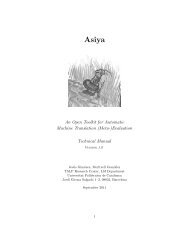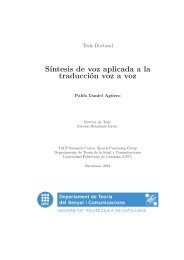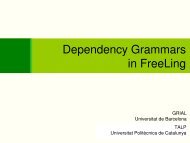FameIr, a Multimedia Information Retrieval Shell - TALP UPC
FameIr, a Multimedia Information Retrieval Shell - TALP UPC
FameIr, a Multimedia Information Retrieval Shell - TALP UPC
Create successful ePaper yourself
Turn your PDF publications into a flip-book with our unique Google optimized e-Paper software.
<strong>FameIr</strong>, a <strong>Multimedia</strong> <strong>Information</strong> <strong>Retrieval</strong> <strong>Shell</strong><br />
M. Bertran, M. Gatius, H. Rodriguez<br />
<strong>TALP</strong> Research Center, Universitat Politècnica de Catalunya<br />
mbertran@lsi.upc.es<br />
gatius@lsi.upc.es<br />
horacio@lsi.upc.es<br />
This paper describes FameIR, a software environment developed for providing IR<br />
capabilities, both indexing and retrieving, when information is represented in different media<br />
(text in various languages, audio, images, video, etc.). FameIR also allows access to information<br />
in Web pages and information services.<br />
Keywords: <strong>Multimedia</strong> <strong>Information</strong> <strong>Retrieval</strong>; Multilingual <strong>Information</strong> <strong>Retrieval</strong>; Web<br />
pages; Web documents<br />
1. INTRODUCTION<br />
Although the initial and, up-to-now most<br />
widely-spread, form of <strong>Information</strong> <strong>Retrieval</strong><br />
(IR) reduces the search space to closed<br />
collections of textual documents and the queries<br />
to (structured) lists of terms typed through the<br />
keyboard, there is a rising interest in i) going<br />
beyond closed collections for facing IR over<br />
open and changing information sources as the<br />
Internet, and ii) allowing other modalities for<br />
both queries and collections in what is<br />
commonly referred to as <strong>Multimedia</strong><br />
<strong>Information</strong> <strong>Retrieval</strong> (MMIR). Some authors<br />
(see [5]), restrict the term MMIR to the case of<br />
multimedia collections, regardless of the query<br />
mode, and use instead the term <strong>Multimedia</strong><br />
Query Processing (or frequently Spoken Query<br />
Processing, SQP) when it is the query that<br />
occurs in non-textual form.<br />
Different media can be used to support the<br />
content of the collections of documents (text,<br />
audio, video, images, etc.). Sometimes,<br />
individual documents are themselves<br />
multimedia (e.g. textual documents including<br />
images, video documents including voice or<br />
textual captions, multimedia Web pages, etc.).<br />
Besides, the fast growth of Internet has<br />
made available a large amount of information<br />
that cannot directly be accessed by conventional<br />
IR technologies, especially that information<br />
generated by web services based on user<br />
request.<br />
This paper describes FameIR, a software<br />
environment designed and built to provide some<br />
of these extended IR capabilities within the<br />
framework of the FAME 1 project.<br />
2. MULTIMEDIA DOCUMENTS<br />
The most extended way of dealing with<br />
multimedia documents (or multimedia<br />
collections) is attaching a set of textual features<br />
to each document during the indexing phase.<br />
Indexes are then built from these sets of textual<br />
features and the query phase is basically the<br />
same as in conventional IR. Queries in this case<br />
consist of textual features and the matching<br />
process is carried out between textual features.<br />
As a result of the searching process, the<br />
information offered to the user consists of<br />
textual information and only in the case the<br />
user wants to access a retrieved document a<br />
specific process depending on the media of the<br />
document is carried out.<br />
Textual features can be words, stems,<br />
lemmas, multiword terms, phrases, etc. They<br />
can include several types of information:<br />
morphological (e.g. part of speech), syntactic<br />
(e.g. syntactic category) and semantic (e.g.<br />
sense). Textual features can be automatically<br />
extracted from multimedia documents or<br />
manually attached to them.<br />
In the case of speech documents (or video<br />
documents including voice) two alternative<br />
options can be chosen. Some systems use<br />
Automatic Speech Recognition (ASR) modules<br />
for automatically translating speech to text and<br />
then proceed as in the previous case. As<br />
expected, this ASR process is not error free and<br />
thus the accuracy of the indexing process<br />
suffers some drop. The other alternative<br />
consists in manually transcribing these<br />
documents and then indexing the resulting<br />
transcripts as described above. This process
assures a higher accuracy at a higher cost of<br />
human effort.<br />
Documents containing images or video<br />
without voice or text explanations are more<br />
difficult to index automatically. In most cases,<br />
indexing is performed manually and even in the<br />
case of carrying out an automatic scene<br />
analysis, human intervention at a post-process<br />
step is usually needed.<br />
A remarkable example of this kind of<br />
approach is ATT's SCAN (Spoken Contentbased<br />
Audio Navigator) system ([4], [12]). The<br />
system allows indexing and querying of<br />
broadcast news stories. Indexing starts by<br />
segmenting each document by topic, detecting<br />
paratones (intonational paragraph boundaries)<br />
using decision trees techniques. Next, a<br />
standard ASR is performed (a WER of 32.4% is<br />
reported by the authors) followed by<br />
conventional indexing of recognised words<br />
using SMART. Querying is performed through<br />
the SCAN user interface (SCAN UI) that allows<br />
relevance judgements, fact finding and<br />
summarisation among other query facilities.<br />
A well-known problem in IR is the Term<br />
Mismatch problem. This problem occurs when<br />
a relevant document is not retrieved due a term<br />
in the query does not occur in the document. In<br />
the case of spoken documents (resulting from<br />
ASR) the problem is worsen because of the<br />
Term Misrecognition problem. This problem<br />
occurs when a relevant document containing all<br />
the terms of the query is not retrieved because<br />
some of the terms have been misrecognized by<br />
the ASR.<br />
Several authors ([11], [5], [6], [8]) have<br />
proposed different approaches to face both the<br />
Term Mismatch and the Term Misrecognition<br />
problems. Among these proposals are document<br />
clustering, dimensionality reduction, document<br />
and query expansion, semantic or phonetic<br />
similarity between words as an alternative to<br />
usual exact-match measures, etc.<br />
In [9], [10] and [14] we can find excellent<br />
reviews of the problems and techniques<br />
presented in this paper.<br />
3. USING FAMEIR<br />
FameIR can manage several collections of<br />
documents referred as MULTIMEDIA<br />
collections. These collections are sets of<br />
documents that can contain multimedia data.<br />
Each document, depending on its type, can be<br />
associated with files containing complementary<br />
material for addressing management of<br />
multimedia data. Considering the different<br />
media used to support the content of the<br />
document there can be five kinds of documents:<br />
� Text document.<br />
� Image document. It consists of a file<br />
containing the image and, optionally, an<br />
associated file with a description of such<br />
image (as a bag of keywords). If the<br />
description is not available, the system<br />
generates a (minimal) default one.<br />
� Voice document. It consists of a voice<br />
file that can be associated with a<br />
transcription file (generated from the<br />
voice document by an ASR module or<br />
manually transcribed or revised) and a<br />
file containing the keywords extracted<br />
from the transcription.<br />
� Video document. It consists of the video<br />
files, the transcription file (as in the<br />
video document) and a keyword file.<br />
� Web document. It consists of the<br />
keyword file describing the web source<br />
and a file containing the following<br />
information: the URL of the web<br />
document, the description of its<br />
structure and, in case of web services,<br />
the parameters needed for accessing it.<br />
There are several scenarios where FameIR<br />
capabilities are used within FAME<br />
environment. Two examples of them are briefly<br />
described next. In the first situation, a set of<br />
related collections (a recorded meeting and<br />
material referred during the meeting) is<br />
accessed using conventional IR techniques. In<br />
the second, the collection of documents is<br />
accessed online using the terms occurring in the<br />
conversation.<br />
Figure 1 shows a schema of the first<br />
scenario. A meeting has taken place and has<br />
been recorded. The whole recorded meeting has<br />
been stored as a single MULTIMEDIA<br />
collection. The documents of this collection are<br />
voice files corresponding to participant's turns<br />
within the meeting. Each document has<br />
attached several metadata, such as time tag,<br />
participant identifier, confidence scoring of the<br />
ASR recognized units, etc. In this case, some<br />
pre-processing is needed. The voice files have<br />
been translated into .asm files by the ASR<br />
module (although a manual transcription could<br />
be done instead). Additional material could also<br />
be indexed and retrieved during the meeting.
Figure 1. Conventional IR access to a Recorded Meeting.<br />
In this scenario the query phase is performed<br />
conventionally. The documents consulted are<br />
basically those in the collection representing the<br />
meeting although other documents previouly<br />
indexed, can also be accessed. Users can type<br />
queries like the following:<br />
Who was the first one to talk about Gaudi?<br />
(The system will retrieve the document<br />
corresponding to the turn of the first participant<br />
in the meeting talking about Gaudi)<br />
Gaudi AND "La Pedrera"<br />
(The system will retrieve all the<br />
interventions indexed by the terms Gaudi and<br />
"La Pedrera")<br />
When was modernism introduced?<br />
Meeting<br />
Recording<br />
Meeting<br />
Recording<br />
...<br />
Speech<br />
Recognition<br />
Module<br />
Explicit mention of cue terms<br />
...<br />
Topic n<br />
...<br />
Doc 1<br />
Doc 2<br />
Doc n<br />
Figure 2. Implicit and Explicit triggering of IR<br />
...<br />
Explicit Query<br />
Detection<br />
Topic<br />
Detection<br />
FameIR<br />
indexer<br />
FameIR<br />
index<br />
of the<br />
collection<br />
User Interface<br />
(The system will retrieve the intervention of<br />
the first participant talking about modernism)<br />
In this situation, the difficulties are restricted<br />
to the indexing task. The documents are<br />
retrieved (together with their confidence scores)<br />
from the collection by the Speech Recognition<br />
Module (SRM), as seen in figure 1. These<br />
documents consist of hypotheses about what<br />
has been said. When weighting the terms of the<br />
documents, not only conventional tf (term<br />
frequency) and df (document frequency) is<br />
considered, but also the confidence scores of<br />
the hypothesised terms. Regarding querying,<br />
several forms of query expansion are presented<br />
to the user.<br />
Query<br />
Already existing<br />
indexed<br />
collections<br />
FameIR
Figure 2 shows a schema of the second<br />
scenario. In this situation, a meeting is taking<br />
place and relevant documents are accessed<br />
online from a set of collections triggered by<br />
explicit or implicit mention of relevant terms<br />
during the conversation. A set of collections of<br />
related material (basically texts and images) has<br />
been previously collected and indexed. Some of<br />
the material comes from Web pages. During the<br />
conversation, explicit IR queries can be<br />
performed such as: Can we get a picture of "La<br />
Sagrada Familia"?. Otherwise, the system can<br />
detect some topics associated with relevant<br />
query terms that can act as implicit queries, as<br />
in: … when Gaudi started the building of "La<br />
Sagrada Familia"…<br />
In this second scenario, all the material has<br />
been collected, pre-processed and indexed in<br />
advance. As already said, two kinds of queries<br />
can be considered, explicit and implicit. The<br />
former requires an Explicit Query Detection<br />
Module. The latter requires a Topic Detection<br />
Module to convert its current formulation into a<br />
real query, as seen in figure 2. In this case, new<br />
difficulties arise in the detection and extraction<br />
of the queries terms from the sentences.<br />
4. FAMEIR FUNCTIONALITIES<br />
AND ARCHITECTURE<br />
In order to face the requirements outlined in<br />
previous section we have designed and built<br />
FameIR (see [1] for a detailed presentation of<br />
the system).<br />
Basic capabilities of FameIR are the<br />
following:<br />
� Indexing, retrieving and presenting<br />
multimedia documents.<br />
� Querying in more than one collection at<br />
a time.<br />
� Cross Language IR (CLIR) covering<br />
both, queries and documents, in<br />
Spanish, Catalan and English, using<br />
EuroWordNet (EWN 3 ).<br />
� Query expansion using EWN.<br />
� Providing access to Web sites.<br />
Figure 3. The initial window of the FameIR interface
External<br />
applications:<br />
-text editor<br />
-image viewer<br />
-sound player<br />
FameIR<br />
configuration<br />
Access to Internet<br />
Wrapper<br />
USER<br />
FameIR interface<br />
Internet<br />
EWN<br />
The basic mode of performance of FameIR<br />
is by means of calls to functions stored in a Perl<br />
library. However, in order to achieve a better<br />
access to collections of multimedia documents,<br />
mainly during the indexing phase, a graphic<br />
interface (see Figure 3) has been built. The<br />
interface facilitates the management of<br />
different collections, the access to original<br />
documents of the collections and the operations<br />
of building and querying them.<br />
FameIR has been built on the top of<br />
Managing Gigabytes (MG 2 ), (described in<br />
[11]), that provides the basic IR capabilities.<br />
Figure 4 presents the general architecture of<br />
FameIR. Users interact with the system through<br />
the FameIR interface. The core of the system is<br />
the MG connection that can be seen as a<br />
wrapper over MG software. All the capabilities<br />
of MG (basically indexing and querying) can<br />
be accessed in this way. A file management<br />
module provides facilities for managing<br />
MULTIMEDIA collections. EWN database,<br />
used for both query expansion and CLIR, can<br />
be accessed by the EWN connection module.<br />
Users can add new synonyms or translations of<br />
the terms of the query from those provided by<br />
EWN.<br />
The system can access external applications<br />
for managing the different types of documents.<br />
The external applications are not part of<br />
EWN connection<br />
Disk<br />
File management<br />
mgbuild<br />
(indexer)<br />
Figure 4. The architecture of FameIR.<br />
MG<br />
collections<br />
MG connection<br />
mgquery<br />
(answerer)<br />
FameIR but can be customised for accessing<br />
them. Among these external applications, a text<br />
editor, an image viewer and a sound player are<br />
currently available. For example, in case a new<br />
image document (.gif or .jpg) is added to the<br />
system, the image is displayed by the image<br />
viewer and a text editor window is offered to<br />
the user for input terms describing the image. In<br />
case of a voice document, the behaviour of the<br />
system depends on the attached files available.<br />
If the ASR (or transcription) file is available, its<br />
content is presented to the user as initial<br />
keyword file.<br />
In FameIR, the set of Web sites that would<br />
be accessed during communication are<br />
previously selected and indexed. The indexing<br />
keywords associated with a Web source can be<br />
generated manually or automatically. The<br />
indexing keywords can be obtained<br />
automatically from the page title, the page<br />
URL, the keywords provided in the page (if<br />
there are any), the words associated with its<br />
address when it is referenced from other pages<br />
or a combination of this information. In the case<br />
of web services where pages are generated on<br />
the fly from some database, based on user<br />
request, they can be indexed either by words<br />
related to the service or by the each possible<br />
page. For example, the Web site Classical Net,<br />
providing information about classical<br />
FameIR
Figure 5. An example of Web page containing different types of data<br />
composers (such as that about Bach shown in<br />
Figure 5), could be indexed by words general to<br />
the site (such as composer, musician, etc.) or by<br />
the name of all the composers described in it<br />
(i.e. Bach, Brahms, Beethoven, etc. ).<br />
The process of obtaining information from<br />
the Web sites is described in next section.<br />
5. ACCESSING THE WEB SOURCES<br />
The content of the Web sites is accessed<br />
during communication by wrappers. In the Web<br />
environment, a wrapper can be defined as a<br />
processor that converts information explicitly<br />
stored as in a HTML document into information<br />
explicitly stored as data structure for further<br />
processing.<br />
We have adapted and enhanced the system<br />
of wrappers of GIWEB, a dialogue system for<br />
accessing web contents (described in [7]). This<br />
system of wrappers is designed to obtain<br />
information from different types of Web<br />
sources, such as corporation Intranets, public<br />
Intranets, Web services, personal pages, etc. In<br />
case of Web services where a set of parameters<br />
is required, this information is obtained from<br />
the terms in the user query (e.g. the departure<br />
and arrival cities in a train service or the person<br />
name in a biography service).<br />
Wrappers can retrieve the whole web page<br />
(including its text, graphics, URL address, …)<br />
or a specific part of it, such as a table (or part of<br />
it) containing train schedules, a particular music<br />
file, all URL addresses, etc. In the FameIR<br />
system, the information retrieved by the system<br />
of wrappers is represented in HTML format or,<br />
alternatively, when retrieving multimedia files,<br />
in the format they appear in the Web source.<br />
For example, the Web page shown in Figure 5<br />
containing different types of data (text, image,<br />
sound, URL address) could be retrieved as one<br />
Web document and also as several documents<br />
of different type: the text documents (a<br />
document can contain the whole text in the<br />
page or part of it, such as the two first<br />
paragraphs), the image file ( in this page there<br />
is only one), the sound files (all of them or just<br />
a set of specific ones) and the web documents<br />
corresponding to the pages addressed (all of<br />
them or a subset of them).
There are several wrapper classes for<br />
dealing with different retrieval tasks. For<br />
example, there is a class in charge of obtaining<br />
all data in a specific column of a table, another<br />
class specialised in obtaining the image<br />
localised in a specific place in the page, etc.<br />
In order to obtain the data, the wrappers<br />
represent the HTML page code as an HTML<br />
syntax tree where nodes are labelled by tag<br />
names. Then, following an explicit description<br />
of the type of data to be retrieved and its<br />
representation in the page (the path of tags to<br />
get it, the tags delimiting it, etc.) the wrapper<br />
traverses the HTML parsed tree and returns the<br />
obtained information. The file describing the<br />
data to be extracted can be created by the user<br />
manually, using the special language provided<br />
by the system. Currently, we are working in the<br />
automatic generation of the description file.<br />
Because the information in the Internet is<br />
represented in heterogeneous sources that<br />
change rapidly, a lot of research has been<br />
dedicated to reduce the cost of obtaining the<br />
information necessary to extract data from a<br />
new site. Several approaches are being<br />
proposed to limit this cost. Basically, those<br />
approaches are based on providing semiautomatic<br />
tools (as those for visually generating<br />
wrappers described in [2]) and wrapper<br />
induction (as in the system described in [4]).<br />
In our system, the knowledge necessary for<br />
obtaining the information from a new page, that<br />
is, the description of the representation of the<br />
data to be extracted, can be generated<br />
automatically using two different methods. The<br />
first method consists of using the description of<br />
the related pages. Usually, in a web site, pages<br />
describing similar contents follow similar<br />
organisation. The second method generates the<br />
description needed from one or more examples<br />
of the data to be retrieved. These examples can<br />
be provided easily by the user by selecting and<br />
copying them from the Web page (in a similar<br />
way of that described in [2]). Once the type of<br />
data and the information about its<br />
representation in the page (its situation in the<br />
HTML syntax tree representing the page, the<br />
tags delimiting the data and those contained in<br />
it,…) is automatically obtained, it is tested and<br />
the results are supervised by the user.<br />
In the system of wrappers we have<br />
developed, if the data retrieved by the system<br />
when using an automatically generated<br />
description of the Web page is not exactly what<br />
the user expected, several strategies are applied<br />
to build new variations of this description. For<br />
example, if a web page contains a table and the<br />
user selects the data contained in the first<br />
column in the first row, the description file<br />
generated will allow the wrapper to obtain all<br />
the data in the first column of the table. In the<br />
case this result would not satisfy the user, a new<br />
description file will be generated which allows<br />
the wrapper to obtain the data in all columns of<br />
the table. If this is not the result desired, new<br />
strategies will be applied to generate other<br />
descriptions and thus allowing the retrieval of<br />
different information.<br />
6. CONCLUSIONS<br />
FameIR, a IR shell developed within the<br />
Fame project for providing extended IR<br />
capabilities has been presented.<br />
FameIR allows management of multimedia<br />
documents: text (in several languages),<br />
graphics, voice, video, etc. It also provides<br />
query expansion and CLIR, using EWN.<br />
FameIR integrates as well a system of wrappers<br />
for accessing the Web and then indexing its<br />
content.<br />
The system can be accessed both through a<br />
graphical interface and through a Perl library.<br />
We are currently working, within the Fame<br />
project, for allowing access to FameIR through<br />
a OAA 5 framework.<br />
REFERENCES<br />
[1] V. Arranz, M. Bertran, H. Rodriguez,<br />
"Computer Environment for Indexing and<br />
<strong>Retrieval</strong> of <strong>Multimedia</strong> Documents", Fame<br />
deliverable D7.1, September 2002.<br />
[2] R.Baumgartner, S.Flesca and G. Gottlob.<br />
“Visual web information extraction with lixto”.<br />
Proceedings of VLDB, 2001.<br />
[3] J. Choi, D. Hindle, J. Hirschberg, F.<br />
Pereira, A. Singhal and S. Whittaker (1999)<br />
“Spoken Content-Based Audio Navigation<br />
(SCAN)”. Proceedings of ICPhS-99, 1999.<br />
[4] W. Cohen and L.S. Jensen, “A<br />
structured wrapper induction system for<br />
extracting information from semi-structured<br />
documents”, Proceedings of IJCAI Workshop<br />
on Adaptive Text Extraction and Mining,<br />
(2001).<br />
[5] F. Crestani (2000) “Exploiting the<br />
Similarity of Non-matching Terms at <strong>Retrieval</strong><br />
Time”. Journal of <strong>Information</strong> <strong>Retrieval</strong>, 2, 25-<br />
45, 2000.<br />
[6] F. Crestani (2002) “Using semantic and
phonetic term similarity for spoken document<br />
retrieval and spoken query processing”. In: B.<br />
Bouchon -Meunier, J. Gutierrez-Rios, R.R.<br />
Yager (eds.): Technologies for Constructing<br />
Intelligent Systems, pp. 363-376, Springer-<br />
Verlag, Heidelberg, Germany, 2002.<br />
[7] M. Gatius, H. Rodríguez. “Natural<br />
Language Guided Dialogues for Accessing the<br />
Web. In the Proceedings of the Fifth<br />
International Conference on Text, Speech and<br />
Dialogue. Brno, Czech Republic,2001.<br />
Springer-Verlag in Lecture Notes in Artificial<br />
Intelligence subseries of LNCS series as<br />
Volume 2448.<br />
[8] H. Joho, C. Coverson, M. Sanderson and<br />
M. Beaulieu (2002) “Hierarchical presentation<br />
of expansion terms”. Proceedings of ACM<br />
SAC, 2002.<br />
[9] M.T. Maybury, ed. (1997) Intelligent<br />
<strong>Multimedia</strong> <strong>Information</strong> <strong>Retrieval</strong>. MIT Press,<br />
1997.<br />
_________________________<br />
[10] P. Schäuble (1997) <strong>Multimedia</strong><br />
<strong>Information</strong> <strong>Retrieval</strong>, Kluwer Academic<br />
Publishers, 1997.<br />
[11] A. Singhal and F. Pereira (1999)<br />
“Document Expansion for Speech <strong>Retrieval</strong>”.<br />
ACM SIGIR’99, pp. 26-33, 1999.<br />
[12] S. Whittaker, J. Hirschberg, J. Choi, D.<br />
Hindle, F. Pereira and Amit Singhal (1999)<br />
“SCAN: Designing and Evaluating User<br />
Interfaces to Support <strong>Retrieval</strong> from Speech<br />
Archives”. ACM SIGIR'99, 34-41, 1999.<br />
[12] I.H. Witten, A., Moffat, Alistair and<br />
T.C. Bell (1999) Managing Gigabytes:<br />
Compressing and Indexing Documents and<br />
Images. Morgan Kaufmann Publishing, San<br />
Francisco, 1999.<br />
[14] J.K. Wu, M.S. Kankanhalli, J-H Lim,<br />
D. Hong (2000) Perspectives on Content-Based<br />
<strong>Multimedia</strong> Systems, Kluwer Academic<br />
Publishers, 2000<br />
1 The FAME (Facilitating Agent for Multicultural Exchange) project develops a new vision for computer<br />
interfaces, which replaces and extends strictly human-computer interaction by computer-enhanced human-tohuman<br />
interaction: http://isl.ira.uka.de/fame/<br />
2 Managing Gigabytes: http://www.cs.mu.oz.au/mg/<br />
3 A generic wide coverage multilingual database with WordNets for several European languages. English,<br />
Catalan and Spanish are used in FameIR: http://www.let.uva.nl/~ewn/<br />
4 Classical Net. http://www.classical.net<br />
5 Open Agent Architecture: http://www.ai.sri.com/~oaa/



